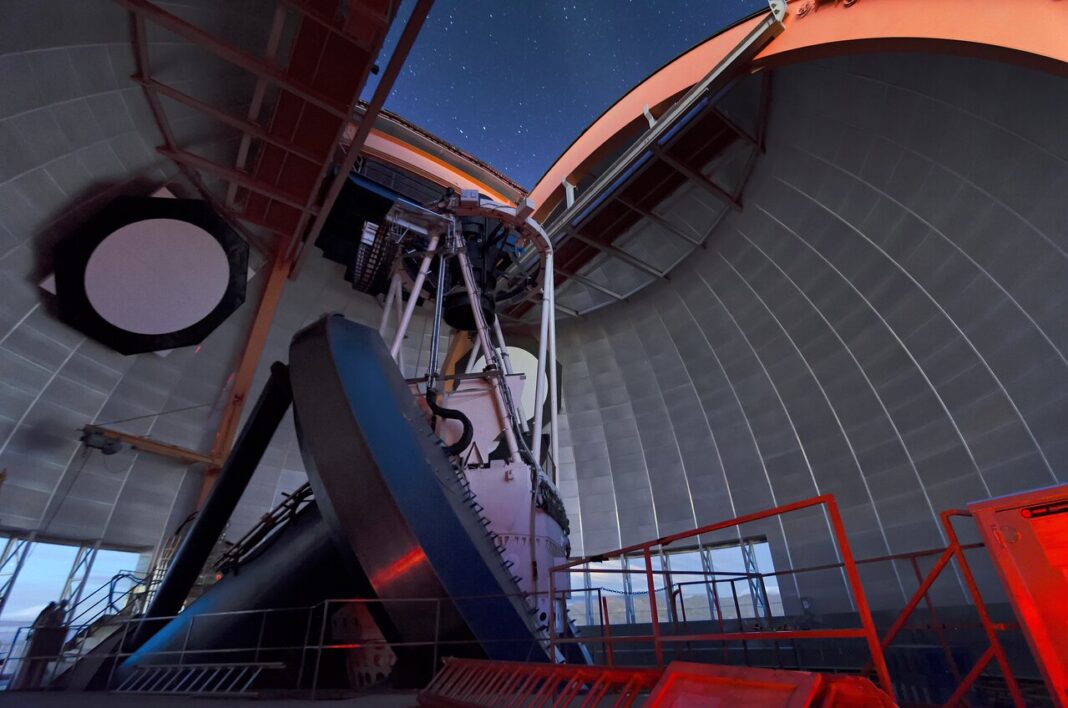Scientists have created the most detailed 3D map of the universe, which includes over 7.5 million galaxies. They used the Dark Energy Spectroscopic Instrument (DESI) to create this map. DESI is the most powerful multi-object survey spectrograph in the world. It consists of over 5,000 optical fibers mounted on the Nicholas U. Mayall 4-meter Telescope at Kitt Peak National Observatory in Arizona. These fibers allow the instrument to capture detailed color spectrum images of millions of galaxies across more than a third of the sky.

Mission to discover the mysteries of the universe
DESI has capped off the first seven months of its survey run by smashing through all previous records for three-dimensional galaxy surveys, creating the largest and most detailed map of the universe ever. Yet it’s only about 10% of the way through its five-year mission. DESI will repeatedly map the distance to 35 million galaxies and 2.4 million quasars across one third of the area of the sky over its five-year run. In ideal conditions, DESI will cycle through a new set of 5000 galaxies every 20 minutes, or more than 100,000 galaxies a night.
The future of the DESI
DESI is an international science collaboration managed by the Department of Energy’s Lawrence Berkeley National Laboratory (Berkeley Lab) with primary funding for construction and operations from DOE’s Office of Science. Once completed, that phenomenally detailed 3D map will yield a better understanding of dark energy, and thereby give physicists and astronomers a better understanding of the past – and future – of the universe.

“There is a lot of beauty to it,” said Berkeley Lab scientist Julien Guy, one of the speakers. “In the distribution of the galaxies in the 3D map, there are huge clusters, filaments, and voids. They’re the biggest structures in the universe. But within them, you find an imprint of the very early universe, and the history of its expansion since then.”
But work on DESI itself didn’t end once the survey started. “It’s constant work that goes on to make this instrument perform,” said physicist Klaus Honscheid of Ohio State University, co-Instrument Scientist on the project, who will deliver the first paper of the CosmoPalooza DESI session. Honscheid and his team ensure the instrument runs smoothly and automatically, ideally without any input during a night’s observing. “The feedback I get from the night observers is that the shifts are boring, which I take as a compliment,” he said.

But that monotonous productivity requires incredibly detailed control over each of the 5000 cutting-edge robots that position optical fibers on the DESI instrument, ensuring their positions are accurate to within 10 microns. “Ten microns is tiny,” said Honscheid. “It’s less than the thickness of a human hair. And you have to position each robot to collect the light from galaxies billions of light-years away. Every time I think about this system, I wonder how could we possibly pull that off? The success of DESI as an instrument is something to be very proud of.”
Tue colors of the dark energy
That level of accuracy is needed to accomplish the primary task of the survey: collecting detailed color spectrum images of millions of galaxies across more than a third of the entire sky. By breaking down the light from each galaxy into its spectrum of colors, DESI can determine how much the light has been redshifted – stretched out toward the red end of the spectrum by the expansion of the universe during the billions of years it traveled before reaching Earth. It is those redshifts that let DESI see the depth of the sky.

The more redshifted a galaxy’s spectrum is, in general, the farther away it is. With a 3D map of the cosmos in hand, physicists can chart clusters and superclusters of galaxies. Those structures carry echoes of their initial formation, when they were just ripples in the infant cosmos. By teasing out those echoes, physicists can use DESI’s data to determine the expansion history of the universe.
“Our science goal is to measure the imprint of waves in the primordial plasma,” said Guy. “It’s astounding that we can actually detect the effect of these waves billions of years later, and so soon in our survey.”

Understanding the expansion of the universe
Understanding the expansion history is crucial, with nothing less than the fate of the entire universe at stake. Today, about 70% of the content of the universe is dark energy, a mysterious form of energy driving the expansion of the universe ever faster. As the universe expands, more dark energy pops into existence, which speeds up the expansion more, in a cycle that is driving the fraction of dark energy in the universe ever upwards. Dark energy will ultimately determine the destiny of the universe: will it expand forever? Will it collapse onto itself again, in a Big Bang in reverse? Or will it rip itself apart? Answering these questions means learning more about how dark energy has behaved in the past – and that’s exactly what DESI is designed to do.
Source:
https://noirlab.edu/public/projects/desi/
https://newscenter.lbl.gov/2022/01/13/dark-energy-spectroscopic-instrument-desi-creates-largest-3d-map-of-the-cosmos/















